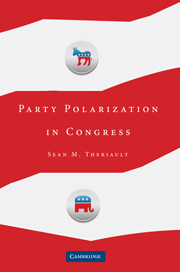Book contents
- Frontmatter
- Contents
- Acknowledgments
- 1 Party Polarization in the U.S. Congress
- PART I BUILDING BLOCKS FOR EXPLAINING PARTY POLARIZATION
- PART II CONSTITUENCY CHANGE
- PART III INSTITUTIONAL CHANGE
- 7 Connecting Constituency Change to Institutional Change
- 8 The Interaction in the Legislative Process
- 9 The Link between the House and the Senate
- 10 Procedural Polarization in the U.S. Congress
- Bibliography
- Index
8 - The Interaction in the Legislative Process
Published online by Cambridge University Press: 05 September 2012
- Frontmatter
- Contents
- Acknowledgments
- 1 Party Polarization in the U.S. Congress
- PART I BUILDING BLOCKS FOR EXPLAINING PARTY POLARIZATION
- PART II CONSTITUENCY CHANGE
- PART III INSTITUTIONAL CHANGE
- 7 Connecting Constituency Change to Institutional Change
- 8 The Interaction in the Legislative Process
- 9 The Link between the House and the Senate
- 10 Procedural Polarization in the U.S. Congress
- Bibliography
- Index
Summary
In 1977, the Democratic party was as dominant as it had been since the heyday of the Johnson administration. In addition to Jimmy Carter's capture of the White House in 1976, Democrats held a 149-seat advantage in the House and a 24-seat advantage in the Senate. Although the minimum wage had just been raised to $2.30 an hour in 1974, economic liberals in Congress and labor unions were again hoping to boost workers' pay. After months of negotiations, labor unions and President Carter agreed on a legislative proposal, which they then sent to Congress. The proposal not only increased the wage to $3.15 but also indexed the wage to 50 percent of the average manufacturing wage. The House Education and Labor Committee quickly reported, on a 29–7 vote, the compromise bill on July 22, 1977.
A week later, the House overwhelmingly adopted, 331–44, the rule for floor consideration of the minimum wage bill. Typical of legislation in the 1970s, the rule allowed any member to amend any part of the bill. When Republicans successfully delayed the bill's debate until after the summer recess, the Chamber of Commerce and other business groups organized a massive grassroots campaign to pressure members of Congress to scale back the minimum wage proposal. Upon reconvening after the Labor Day recess, the full House took up the bill. The Republican efforts to scale back the bill won on the first vote of the debate.
- Type
- Chapter
- Information
- Party Polarization in Congress , pp. 156 - 195Publisher: Cambridge University PressPrint publication year: 2008



